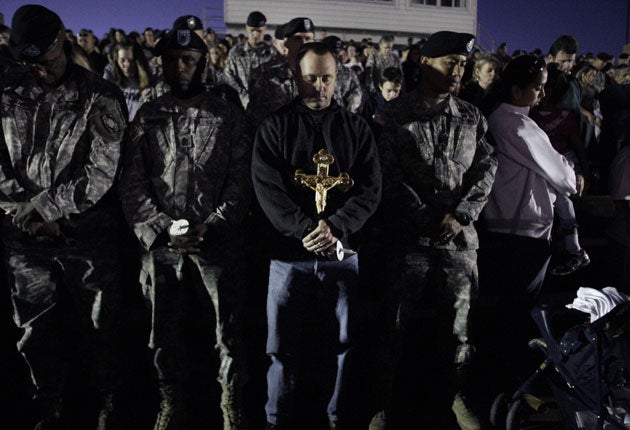Army killer 'had time to reload repeatedly'
Details are emerging of the shooting that left 13 dead and more than 30 wounded at an army base in Texas

Army investigators working to reconstruct in second-by-second detail the one-man rampage inside a soldier processing facility at Fort Hood, Texas, on Thursday, are asking how the assailant had time to fire at least 100 rounds from a single handgun. The incident left 13 dead and more than 30 wounded.
Some survivors of the carnage, made even more deadly by ricochet bullets bouncing from walls, furniture and floor tiling, have told investigators that the suspect, Major Nidal Malik Hasan, an army psychiatrist who faced imminent deployment to Afghanistan, was almost methodical in his slaughter. In some instances, he fired a second time at soldiers who were wounded but not yet dead.
Officials said Hasan bore two non-military handguns on entering the building. But after climbing first on to a desk and shouting "Allahu Akbar!", or "God is great!", he used only one, a Belgian semi-automatic pistol with an extended magazine that holds 20 bullets. This implies that Hasan reloaded as many as five times before he was brought down by two civilian police officers.
Hasan, 39, was transferred to a San Antonio hospital last night. He remained unconscious and according to sources has been paralysed by his wounds. His condition was serious but stable. Officials said Hasan was hit at least four times by the two police officers.
One survivor, Keara Bono, recalled yesterday that at first she thought the incident was a drill. She was among scores of personnel inside the building which is used to screen soldiers returning from duty abroad and to prepare others before their deployments, notably with health checks and vaccinations. "Then I looked to my left and right and I saw people bleeding," Ms Bono, who suffered a graze to the head and a light back wound, told ABC News. That's when she knew the attack was not pretend. "I started crawling. I turned back and looked at him. He was about two body lengths away from me, shooting people on the ground. So I was just waiting to get shot in the back."
Another who was hit, Grant Moxon, came out alive only because he played dead, his father said in interviews. "He said he looked up, and this guy is standing there looking at him right in the face. All of a sudden, he pulled up a gun and started shooting."
Dedicating his weekend radio address to the tragedy, President Barack Obama called it "all the more heartbreaking and all the more despicable because of the place where it occurred and the patriots who were its victims".
As investigators search for a motive for the killings, a more complete picture of the suspect is emerging. Hasan joined the military after high school in return for his medical training, but, as a Muslim, had become deeply conflicted about his place in the army and about the wars in Iraq and Afghanistan. Relatives have also confirmed that he was mortified about being posted to war himself.
A Muslim community leader in Killeen, the town beside Fort Hood, talked for the first time about difficult conversations he had had with Hasan over the summer, when Hasan had asked for guidance on what he could say to US soldiers worried about being asked to kill Muslims in Afghanistan and Iraq. Osman Danquah, a co-founder of the Islamic Community of Greater Killeen, said they discussed the issue twice. While he never heard any expressions of anger towards the army, or indications that he might commit violence, on the second occasion Hasan had become mildly incoherent. "There is something wrong with you," Mr Danquah recalled telling Hasan.
The shooting is casting a spotlight on the army's efforts to appreciate the stress that is experienced by members of the military after nearly eight years of overseas wars.
"We have been trying hard to understand the effects of stress, to understand the causes of everything from domestic violence to suicide to other crimes," said John McHugh, the Secretary of the US Army, during a visit to the base. The former president, George W Bush, paid a surprise visit to Fort Hood late on Friday. Hundreds on the base, the largest in the world, also attended an evening vigil for the dead, led by the Army Chief Chaplain, Douglas Carver. "Remember to keep breathing. Keep going," the chaplain told the crowd.
Hasan was born in Virginia of Palestinian parents, neither of whom are still living. His relatives in the Middle East expressed consternation over the shooting. "He is a doctor and loves the US," contended his grandfather, Ismail Mustafa Hamad. "Whether he became angry or something else, I don't know. What I do know is that it is impossible that he would do something like that."
Those killed in the tragedy included Francheska Velez, 21, of Chicago, who was pregnant and, after a tour in Iraq, was preparing to return to her family. Also from Chicago was Michael Pearson, 21, who, said his family, was eager to serve his country and left his job at a furniture company to join the army. Michael Grant Cahill, meanwhile, was 62 and a civilian volunteer doctor's assistant; he had suffered a heart attack only two weeks before but had returned to work after a week's sick leave. "He loved his patients, and his patients loved him," said his grieving daughter, Keely Vanacker, 33, the oldest of his three adult children.
Join our commenting forum
Join thought-provoking conversations, follow other Independent readers and see their replies
Comments
Bookmark popover
Removed from bookmarks